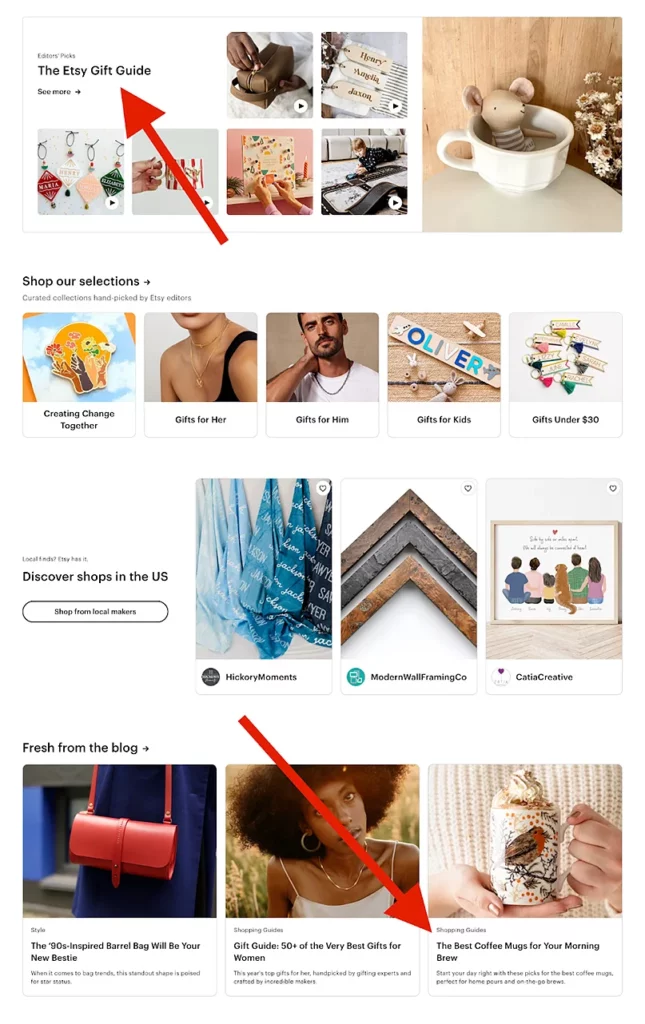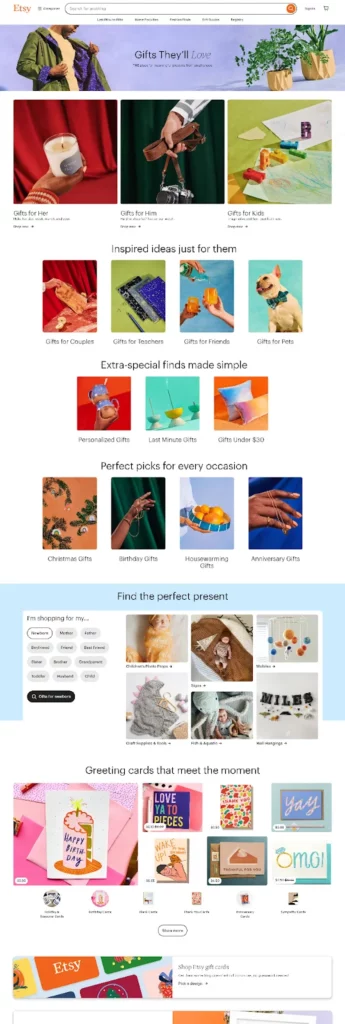A product buying guide, also known as a buyer’s guide and shopping guide, is like your go-to source for getting all the nitty-gritty details about the product you want to buy.
It’s there to help you compare different options, figure out what’s best for you, and make smart choices when you’re shopping.
Typically found in various formats such as online articles, brochures, or digital catalogs, these guides aim to educate consumers about the features, benefits, and potential uses of products within a specific category.
They might even include tips for product selection, usage instructions, and other relevant details to help you pick the right one and make the most of what you want to buy.
Platforms like Etsy and Amazon have set exemplary standards with their buying guides, showcasing the power of curated recommendations and valuable insights for shoppers.

Image: Etsy’s Shopping Guides on its homepage.
Shopping guides can be an effective tool for e-commerce brands to not only boost product sales but also assist buyers, thus providing a positive customer experience.
How to write a product shopping guide?
There are various ways to write product shopping guides for your ecommerce site.
Here we have discussed some of the important points and best practices to optimize the buying guides for better customer experience and boosting sales:
1. Speak to Your Audience
Write like you’re having a conversation with your readers. Answer their burning questions and dish out the info they need to pick the perfect product. Give them the lowdown on what they need to know.
2. Keep It Simple
Don’t go overboard with details for straightforward products. But for the more complex stuff, dive deep. And skip the obvious stuff like “It’s your choice what color you pick.”
3. Creating Collections and Segments
By strategically creating and promoting themed collections and segments, you’ll not only boost sales but also help your customers easily decide on gifts or products, and enhance the buying experience.
Here’s why they matter:
- Targeted relevance: Holiday gift guides, seasonal collections, and niche segments speak directly to your customer’s current interests and needs. They simplify choices, saving them time and effort.
- Increased sales: By grouping related products, you encourage cross-selling and impulse purchases. Imagine a winter coat collection paired with cozy scarves and gloves – irresistible!
- Brand storytelling: Collections can showcase your brand’s values and personality. A “Sustainable Kitchen Essentials” segment highlights your commitment to eco-friendly choices.
- Community building: Create collections around shared interests (e.g., “Backyard BBQ Essentials”). This fosters a sense of belonging and loyalty among customers.
Curation and Promotion Tips:
- Know your customer: Analyze purchase data and customer feedback to identify trends and preferences.
- Theme it up: Choose themes relevant to current events, seasons, or holidays. Think “Spooky Halloween Costumes” or “Cozy Winter Reads.”
- Variety is key: Offer a mix of popular and lesser-known products within each collection.
- Limited-time offers: Create a sense of urgency with exclusive discounts or flash sales for collection items.
4. Use Videos
Videos bring shopping guides to life!
They showcase products in action, building trust and making features clear, while shoppable elements and interactive quizzes guide buyers smoothly to the perfect purchase.
- Shoppable videos: Integrate product links directly into the video, allowing viewers to seamlessly click and purchase items they see on screen.
- Interactive elements: Add quizzes, polls, and decision trees to videos, personalizing the experience and guiding viewers towards the right product for their needs.
Benefits for buyers:
- Convenience: Shoppable videos eliminate the need to switch between the guide and the shopping cart, making the buying process smooth and efficient.
- Personalization: Interactive elements offer a tailored experience, helping buyers find products that truly match their needs and preferences.
- Enhanced understanding: Videos better illustrate complex features and functionalities, leading to more informed purchasing decisions.
- Entertainment and engagement: Interactive videos turn the shopping guide into a fun and engaging experience, making research and product discovery enjoyable.
5. Optimize it for a great user experience
When creating a great shopping guide, it’s important to ensure that it’s easy for your readers to use. Here’s how to make it user-friendly:
- Design for Easy Navigation
- Keep it simple: Make sure your guide is easy to navigate, with clear sections and a logical flow.
- Use visual aids: Include images, icons, or infographics to break up text and make it more engaging.
- Clear language: Keep your writing clear and straightforward, avoiding jargon or confusing terminology.
- Mobile-Friendliness and Accessibility
- Go mobile: Ensure your guide looks and works great on mobile devices, so people can access it anytime, anywhere.
- Accessibility matters: Consider users with disabilities by using accessible design elements and ensuring compatibility with assistive technologies.
6. Incorporate Expert Recommendations
Featuring expert voices can make your shopping guide more engaging and authoritative.
Expert recommendations add a layer of credibility and trust to your shopping guide. Consumers are more likely to believe and act on recommendations from people they perceive as knowledgeable and unbiased.
Including expert recommendations can help you avoid tunnel vision and present a more balanced perspective in your shopping guide.
Experts can offer insights from different angles and experiences, often pointing you towards lesser-known but equally great products that might not be on your radar. ensuring your guide caters to a wider range of readers with diverse needs and priorities.
- Choose the right experts: Select experts who are relevant to your product category and have a proven track record of knowledge and expertise.
- Quote them strategically: Don’t just sprinkle quotes throughout your guide. Integrate them seamlessly into your narrative to support your points, highlight key features, or offer alternative viewpoints.
- Provide context and attribution: Always introduce the expert by name and credentials, and clearly indicate where their quotes come from. This adds transparency and builds trust with your readers.
7. Stand Out from the Crowd
Use your guide to shine a light on what makes your products special. If your product is turbocharged with extra cores, make sure to let them know that’s your unique selling point.
8. Format Like a Pro
Use bullet points, keep it active, and throw in some tables for easy comparisons. Show them what a step-by-step purchase looks like and highlight the must-have features.
Essential Sections of a Compelling Buying Guide:
A well-crafted buying guide is your reader’s roadmap to making informed purchasing decisions. It navigates the complexities of a product category, simplifies choices, and instills confidence. Here’s a breakdown of essential sections to include:
1. Introduction:
- Hook: Grab attention with a relatable scenario, surprising statistic, or intriguing question about the product category.
- Context: Briefly explain the purpose of the guide and what pain points it addresses for the reader.
- Target audience: Define who this guide is for, whether it’s tech enthusiasts, budget-conscious families, or eco-conscious consumers.
2. Understanding the Product Category:
- Benefits and drawbacks: Explain the overall value proposition of the product category and its potential benefits for the reader. Discuss any common drawbacks or limitations to set realistic expectations.
- Key features and specifications: Break down the core features that differentiate products within the category. Explain technical terms in simple language and highlight what matters most for the reader.
- Comparison matrix: If applicable, create a comparison table highlighting key features and specifications of popular product options. This provides a quick side-by-side view for decision-making.
3. Evaluating and Choosing the Right Product:
- Budget considerations: Discuss different price points within the category and offer guidance on allocating budget based on individual needs and priorities.
- Brand reputation and reviews: Provide information on reputable brands and highlight trustworthy review sources to help readers assess product quality and performance.
- Decision-making factors: Identify the key criteria readers should consider when comparing products, such as specific features, compatibility, warranty, and brand values.
- Product recommendations: Based on your analysis, offer specific product recommendations tailored to different needs and budgets. Briefly explain why each recommendation is suitable for a particular type of user.
4. Additional Resources:
- Glossary of terms: Define any technical terms used throughout the guide for easy reference.
- FAQs: Address common questions readers might have about the product category or specific models.
- Links to further resources: Provide links to relevant articles, reviews, or manufacturer websites for deeper exploration.
5. Conclusion:
- Recap key takeaways: Briefly summarize the main points covered and reiterate the value of using the guide.
- Call to action: Encourage readers to take the next step, whether it’s visiting a recommended product page, subscribing to your newsletter, or sharing the guide with others.
Buyer’s Guide Examples
Etsy had dedicated special landing pages for different types of guides. For example, they have a huge collection of gift guides under a dedicated tab.
They have organized the gift guides based on gender, preferences, seasonality, age, relationship, purpose.
See how they have made it easy and interactive for buyers to check the collections and choose the perfect product for every occasion:

We then chose to open of the shopping guides to help you visualize the format and elements of individual product shopping guides:

Let your audience know what makes your company stand out and why your products are top-notch. Throw in some solid data and tips to help them decide if your products are the right fit for them. And there you have it! A great buying guide.
